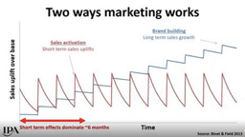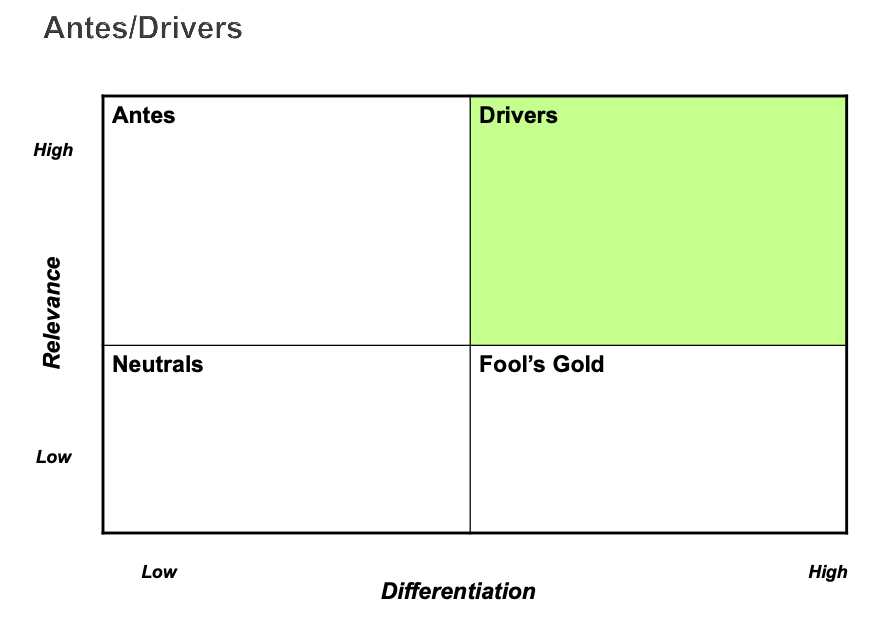Here’s the scenario: you’re cruising along as one of the top brands in your category. You’re top-of-mind for many consumers, sales are growing annually, and then, what feels like all of a sudden – within a few sales cycles – the economy dips, new competition enters the market, and existing competition ups their game. All of which start eating away your market share. What can you do to maintain a prime position and not fall by the wayside?
You can't rest on your laurels.
Yes, you likely have a good base of loyal customers, seeing as you’ve been the market leader. Let’s say that “loyal” group makes up 40% of your total customers each year – are you willing to risk that other 60%? Plus, your loyal base will likely be eroded bit by bit over time, either being drawn to the competition or dropping out of the market for your product.
“Ultimately, progress and innovation win.” – Travis Kalanick, founder of Uber.
Kalanick might not be the leadership role model we should emulate ourselves after, but this succinct quote hits the mark. Customers are drawn to and excited by innovation. Try to inject something new to your brand’s offering on a regular basis. This gives your customers a reason to re-engage with your brand, and also helps keep your marketing energized.
But, don’t throw the baby out with the bathwater.
Remember, you are a market leader. You’re clearly doing plenty right. Don’t get so caught up in the pursuit of innovation that you let go of the things that made your brand successful in the first place. Protect the pillars of your success.
Cost cutting should not be the immediate response.
Yes, fiscal responsibility is very important. If there are ways to be more efficient with your dollars without sacrificing revenue and brand equity, by all means, take advantage of those savings. But we’ve seen that when brands cut for the sake of cost savings, they fall out of competition even more – out of sight, out of mind.
On the contrary, increased competition and market threats may mean it’s time to consider investing – whether that’s in product innovation, understanding your customers (and potential customers) more deeply, marketing, sales channels, or your customer experience.
Watch your competition like a hawk.
This might be an obvious one, but it’s worth reinforcing. And yes, I’m talking about even the smaller competitors who aren’t hot on your tail. Do their moves give you any intel about what they’re seeing in the market, or a sense of where they’re heading in the longer term?
Let your competition be the guinea pigs.
You don’t always have to be first to market with something. I’m not talking about big, category redefining things here – you probably don’t want someone to beat you to those. But, is there something you’ve been tossing around the idea of doing for a few months, but have been nervous or unsure about whether or not it will pay off? Then, you see some of your competition make the switch? Good for them! Now you get to learn from it (because you’re so aware of your competitors). If it seems to pay off, you can feel more confident rolling it out in your own brand. And if doesn’t, phew, you dodged that bullet! Or, maybe you gained insight on how to do something even better.
Don’t forget about the importance of brand building.
With such emphasis on digital marketing and all the data and metrics we have access to measuring, many marketers end up focusing primarily on short term activation efforts (and the immediate results) and are investing less in longer term brand building. Earlier this summer, WARC (a great resource for marketers) published a white paper about marketing effectiveness. Included in that was reference to work done over the last number of years by Les Binet and Peter Field about short and long-term effectiveness, and balancing spend between Brand Building and Sales Activation.
Olivia Alderson of WARC does a good job explaining the differences:
On the one hand, there is brand building. The essence is to create memory patterns on people to make them feel good about the brand. These people won't necessarily buy in the moment, but rather in the future. Each exposure to a brand building campaign creates incremental effects which produce long term sales growth.
On the other hand, there is sales activation. Unlike brand building, the aim here is to stimulate sales by identifying the people who are shopping in the moment and making them buy right now. That requires a much more targeted approach and smaller budgets. When done properly the strategy results in high sales in the short term, but these decay over time.
This image (from Binet & Field) illustrates the return or effectiveness of Brand Building and Sales Activation over time.

(The source article by Olivia Alderson is here. You can download the full WARC whitepaper here.)
Mine for and focus on your meaningful differentiators.
The last comment I’ll make is that it can be hard to find ways to be meaningfully different from competition. Not that you become a commodity, but you and your competitors might offer many of the same core products and benefits, leading to parity in the eyes of consumers.
One tool that has come in handy for my clients and I is the “Antes & Drivers” chart, which I was introduced to through a course with the ICA (Institute of Communications Agencies).

Think about your brand’s features, benefits, selling points and the marketing messages you use and try to plot them in here to help shine a light on what you ought to be focusing on.
- “Antes” are table-stakes – the things that aren’t very differentiating, but are important for brands to offer in the category because they’re relevant to audiences.
-
“Neutrals” are like shrugs – most of the brands offer the same, but audiences don’t care too deeply about them.
-
“Drivers” are just that – drivers of your success. They are both highly relevant to your audiences and differentiating from your competition.
-
Beware the “Fool’s Gold” – where many brands try to differentiate themselves, but don’t actually drive the brand or sales forward because these differences aren’t very meaningful to audiences.
It’s undoubtedly unnerving when your comfortable position gets shaken. Hopefully, with the help of the tips above, your brand can not only withstand market shifts and increased competition but also emerge stronger and more resilient.
If you would like to chat a bit more about how we can help maintain a strong position for your brand, feel free to shoot us a message.

